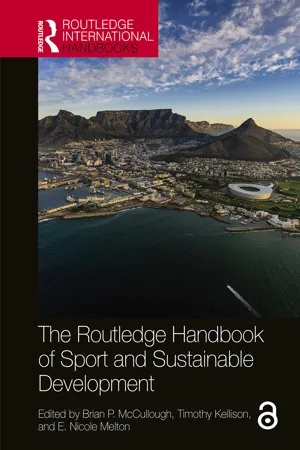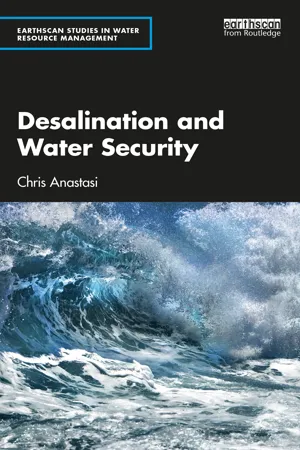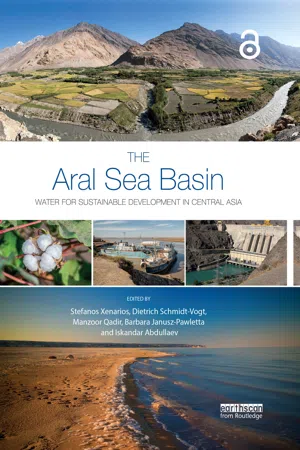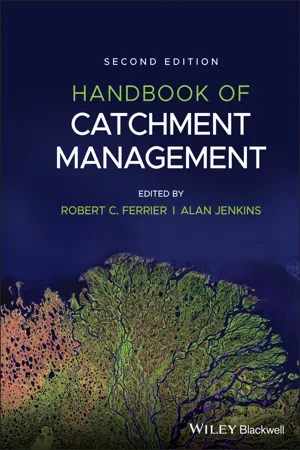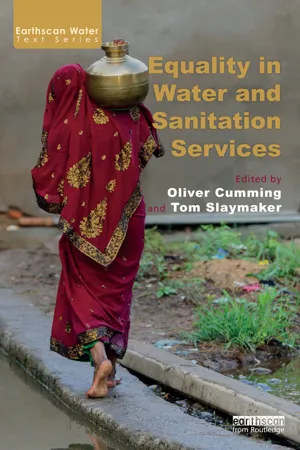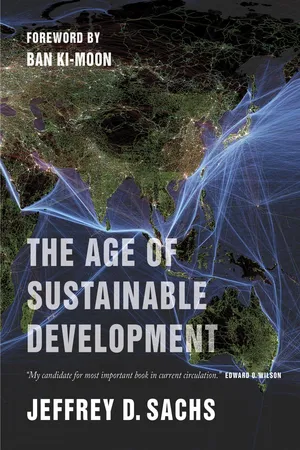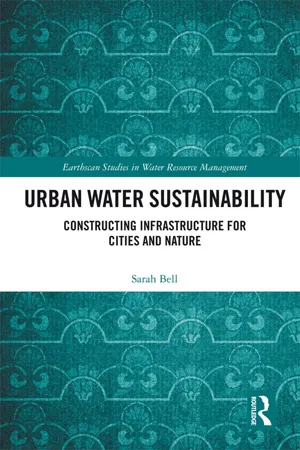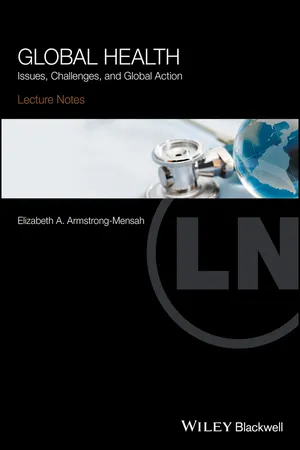Geography
Sustainable Development Goal 6
Sustainable Development Goal 6 (SDG 6) aims to ensure access to clean water and sanitation for all. It focuses on improving water quality, reducing pollution, and protecting and restoring water-related ecosystems. SDG 6 also emphasizes the importance of water efficiency and sustainable water management practices to address water scarcity and ensure the availability of water for all.
Written by Perlego with AI-assistance
Related key terms
Related key terms
1 of 4
Related key terms
1 of 3
11 Key excerpts on "Sustainable Development Goal 6"
- Brian P. McCullough, Timothy Kellison, E. Nicole Melton, Brian P. McCullough, Timothy Kellison, E. Nicole Melton(Authors)
- 2022(Publication Date)
- Routledge(Publisher)
sanitation-related activities and programmes, including water harvesting, desalination, water efficiency, wastewater treatment, recycling and reuse technologies 6.b Support and strengthen the participation of local communities in improving water and sanitation management Source : General Assembly (2015). The targets and indicators outlined by SDG 6 focus on holistic management of water resources, addressing everything from access to clean water and sanitation, to the community level development and capacity building necessary to continue managing these resources into the future. As it stands, much of the world’s water use is for agriculture and electricity, rather than for individual residential use. In the United States, the USGS reports that only about 12% of the water use is attributed to public supply (Dieter et al., 2018). The largest users are typically using the resource for economic gains, like for thermoelectric power or agriculture (Dieter et al., 2018). Water faces many of the traditional economic challenges. Like the “race to fish,” in a world with an uncertain supply of water resources or a demand greater than the resource can support, water becomes a resource with individuals and groups racing to extract, often resulting in an unequal distribution and economic losses. 17.2 Scope of global water issues The SDGs are classified into three categories, and Goal 6 falls under “environment,” as it focuses on water resources. The Sustainable Development Goals Report 2018 has been monitoring the state of sustainable development since 2015, and holds that the greatest barrier is lack of funding, once again bringing the conversation back to the “who pays” divide- eBook - ePub
- Lynette de Silva, Chris Maser(Authors)
- 2021(Publication Date)
- CRC Press(Publisher)
22BOX 9.2Sustainable Development Goal 6Goal 6: Ensure availability and sustainable management of water and sanitation for all- 6.1. By 2030, achieve universal and equitable access to safe and affordable drinking water for all
- 6.2. By 2030, achieve access to adequate and equitable sanitation and hygiene for all and end open defecation, paying special attention to the needs of women and girls and those in vulnerable situations
- 6.3. By 2030, improve water quality by reducing pollution, eliminating dumping, and minimizing release of hazardous chemicals and materials, halving the proportion of untreated wastewater and substantially increasing recycling and safe reuse globally
- 6.4. By 2030, substantially increase water use efficiency across all sectors and ensure sustainable withdrawals and supply of freshwater to address water scarcity and substantially reduce the number of people suffering from water security
- 6.5. By 2030, implement integrated water resources management at all levels, including through transboundary cooperation as appropriate
- 6.6. By 2020, protect and restore water-related ecosystems, including mountains, forests, wetlands, rivers, aquifers, and lakes
- 6.a. By 2030, expand international cooperation and capacity building support to developing countries in water- and sanitation-related activities and programs, including water harvesting, desalination, water efficiency, wastewater treatment, recycling, and reuse technologies
- 6.b. Support and strengthen the participation of local communities in improving water and sanitation management
Of these, Target 6.5 is of particular importance to our discussion of the global water crisis, the challenge of managing internationally shared waters, and the Four Stages of Water Conflict Transformation. Target 6.5 states, “By 2030, implement integrated water resources management at all levels, including through transboundary cooperation as appropriate.”23 This target was included in Goal 6 because several organizations and stakeholders argued that its inclusion would improve domestic management and transboundary water cooperation.24 - eBook - ePub
- Chris Anastasi(Author)
- 2024(Publication Date)
- Routledge(Publisher)
end hunger, achieve food security and improved nutrition and promote sustainable agriculture, while the SDG3 focus is to ensure healthy lives and promote well-being for all at all ages; to achieve these SDGs, it requires plentiful and secure supplies of freshwater. In a broader context, the provision of utilities such as water, energy, and communications are all important for SDG11, which seeks to make cities and human settlements inclusive, safe, resilient, and sustainable.Social drivers
Population, directly and indirectly, has, arguably, been the single largest driver of water demand. The global population 2000 years ago was estimated at around 230 million, a number reached after 10,000 years of human development. The time taken to double the global population has since fallen dramatically: 1,400 years the first time, 380 years the second time, 135 years the third time, and 57 years the fourth time, so that by 1972 the population was 3.82 billion; the population doubled again just 48 years later in 2020 to 7.84 billion. This is an astonishing outcome, brought about by the increased availability of food and water, the development of medicines and the eradication of diseases, and the development of new technology to aid human activities. These have led to declining death rates among the young, particularly in developing countries, and extended average lifetimes for the old; it is now not uncommon for people in the developed nations to live into their 80s.In terms of geographical distribution, Asia had the largest population in 2020, at just under 60% of the world total; China and India were the most populous, each contributing around 18% of the total. In terms of age distribution, Asia has 24% of its population below the age of 15 and just 10% over the age of 65. Europe and Africa are at different ends of the population spectrum. Europe, which contributes 10% of the world population, has a markedly different distribution: just 16% of its population is under the age of 15, while almost 20% are over the age of 65. Africa contributes 17% to the world population, with an age distribution of 40% below the age of 15 and just 3% above the age of 65. - eBook - ePub
The Aral Sea Basin
Water for Sustainable Development in Central Asia
- Stefanos Xenarios, Dietrich Schmidt-Vogt, Manzoor Qadir, Barbara Janusz-Pawletta, Iskandar Abdullaev(Authors)
- 2019(Publication Date)
- Routledge(Publisher)
Tajikistan remains one of the poorest states among the Basin countries and its economy is particularly susceptible to the effects of the global economic crisis. The president of Tajikistan has emphasized the importance of water issues and especially of the dispute on water reservoirs with Uzbekistan. Consequently, the agenda of SDG 6 is Tajikistan’s priority, followed by the development of the agricultural sector, improving quality of social services, reducing unemployment, and improving access to universal education to eliminate poverty.Turkmenistan is a regional leader in the adaptation of the Sustainable Development Goals at the national level, in particular, with respect to optimizing the use of water resources. In September 2018, President Gurbanguly Berdimuhamedov published a book, On the Way to Achievement of the Sustainable Development Goals in Turkmenistan , to present the enormous amount of work carried out in the country.Uzbekistan works closely with the UN agencies to fulfill the SDGs. The country aims to improve the access of the urban and rural population to clean drinking water and sanitation. Another priority for the government is to enhance the energy efficiency of production, and to develop the energy sector, based on renewable energy sources such as hydropower. The country is working toward creating intersectoral synergies through the nexus approach.Current status of SDG 6 on clean water and sanitationA study on implementation of SDGs within the SPECA region (Alzhanova 2017 ) identified the most important goals for the Aral Sea Basin countries. The results of this analysis in an aggregated form are presented in the figure below (Figure 13.1 ). SDG 6 on Clean Water and Sanitation was referred to as one of the most critical for the region, while SDG 13 on Climate Action was also mentioned as a priority across all states.The framework of SDGs provides not only individual goals and targets but also relevant indicators. Through vigorous discussions, these indicators were agreed upon by the Member States to ensure fair monitoring of the progress in sustainable development by each country, both developing and developed. In the case of Goal 6, 11 indicators correspond to the eight targets in total. Table 13.1 - eBook - ePub
- Simon Sneddon(Author)
- 2023(Publication Date)
- Routledge(Publisher)
4ACTIVITYThere is an inherent inequality present in the use of water, illustrated by the fact that in the UK the infrastructure is designed so that water used for washing and sanitation is of the same quality as drinking water, whereas 2 billion people lack access to clean drinking water.What mechanisms could be used to improve achievement of SDG 6.1?5.8 SDG 7: Affordable and Clean Energy
The links between energy policy and sustainable development in the UK are covered in more depth in Chapter 6 .SDG 7 focuses both on the generation and use of energy, as energy efficiency and increased use of renewable sources are both vital to avoid the worst effects of climate change. In addition, energy needs to be affordable and reliable; otherwise, the impact of its use will be greatly reduced.With the exception of Target 7.1, none of the targets in SDG 7 are precise and quantifiable. Even so, the UN raises both the COVID pandemic and the war in Ukraine as factors impacting on the likelihood of achieving the goals.Target 7.1: By 2030, ensure universal access to affordable, reliable, and modern energy services. Over 700 million people have no access to electric light and, as we saw earlier, 2.4 billion are using potentially lethal open fires for cooking. The UN recognises that progress has been good, but still falls short of the 2030 deadline without a doubling of the rate of increase in the next few years. Target 7.2: By 2030, increase substantially the share of renewable energy in the global energy mix. Globally, renewable energy accounted for 17.7% of total global energy production in 2019 (but 26% of electricity generation). - eBook - ePub
- Robert C. Ferrier, Alan Jenkins, Robert C. Ferrier, Alan Jenkins(Authors)
- 2021(Publication Date)
- Wiley-Blackwell(Publisher)
2011 ). The current SDG reserves a special chapter for ‘clean water and sanitation’ (Goal 6), with sub targets and indicators as follows:SDG targets and global indicators for household WaSHSDG 6 target SDG 6 indicator Additional global indicators tracked by Joint Monitoring Programme (JMP) SDG 6.1: By 2030, achieve universal and equitable access to safe and affordable drinking water for all SDG 6.1.1: Proportion of the population using safely managed drinking water services Service levels: basic servicea , limited service, surface water Facility types: piped water, non‐piped improved SDG 6.2: By 2030, achieve access to adequate and equitable sanitation and hygiene for all and end open defecation, paying special attention to the needs of women and girls and those in vulnerable situations SDG 6.2.1.a: Proportion of population using safely managed sanitation services SDG 6.2.1.b: Proportion of the population with a handwashing facility with water and soap (also tracked as basic servicea ) Service levels: basic servicea , limited service, open defecation bFacility types: sewer, septic, latrines, and other improved Service levels: basic servicea , limited service, no serviceGoal 6 intersects with several other elements of the SDGs directly or indirectly including good health and well‐being (Goal 3). It is also indirectly related to the goal of eliminating poverty (goal 10), securing gender equality (goal 5), and promoting economic growth (goal 8).SDG sub‐indicator for global reporting on SDG 1.4.aSupplementary indicator for global reporting on SDG 6.2.bSource: Bain et al. (2018 - eBook - ePub
- Oliver Cumming, Tom Slaymaker, Oliver Cumming, Tom Slaymaker(Authors)
- 2018(Publication Date)
- Routledge(Publisher)
The Sustainable Development Goal (SDG) on water and sanitation is a huge improvement on the MDG targets, and the impact of subsequent discourse on the human rights to safe drinking water and sanitation is reflected in the formulation of the targets and indicators. The SDG target seeks by 2030 to achieve universal and equitable access to safe and affordable drinking water for all, as well as access to adequate and equitable sanitation and hygiene for all and an end open defecation, paying special attention to the needs of women and girls and those in vulnerable situations. In addition, water quality concerns that were missing from the MDGs are addressed, including a commitment to reduce the number of people suffering from water scarcity and support, and to strengthen the participation of local communities in improving water and sanitation management. The importance of strengthening the wider water management environment, as well as immediate supply access, recognizes that equality in supplies may be hindered significantly if the resource base itself is inadequately managed and maintained, both in terms of the availability of quantities and the overall quality of the resource.Still, like the other SDGs, there is a risk that there are too many indicators and hence problems with monitoring and tracking, and the risk of an SDG monitoring industry emerging in each country, with an over-emphasis on tracking numbers of beneficiaries and an under-emphasis on tracking qualitative differences in access. In common with the MDGs, there is also a lack of clear mechanisms of accountability and similarly a definition of each goal and target at more specific national and subnational levels. These will always be different and need to be locally defined. Also generalized, globalized arguments that underpin policy debates tend to remain disconnected from the everyday experiences of local people. The ‘service ladder’ used for monitoring target 6.1 (see Chapter 12 ) is far more nuanced than the binary improved/unimproved classification used for MDG monitoring. However, as Welle52 - eBook - ePub
- Jeffrey D. Sachs(Author)
- 2015(Publication Date)
- Columbia University Press(Publisher)
Ensure availability and sustainable management of water and sanitation. This goal seeks to ensure that every person has access to safe and affordable drinking water, as well as sanitation and hygiene. The goal also calls for large strides in reducing water pollution and raising the efficiency of water use.SDG 7: Ensure access to affordable, sustainable modern energy. This goal aims to end “energy poverty,” in which households lack access to electricity and safe cooking fuels. The targets include major strides in the provision of renewable (low-carbon) power and in energy efficiency.SDG 8: Promote sustainable economic growth and decent work for all. SDG 8 might be considered the economic development goal. SDG 1 calls for ending extreme poverty; SDG 8 calls for economic growth to raise incomes per person and to enable today’s poor countries to narrow the gap with high-income countries. Targets also emphasize full employment, decent work, labor rights, and the end of modern slavery and human trafficking.SDG 9: Build resilient infrastructure and promote sustainable industrialization. SDG 9 recognizes that many countries in the developing world lack key infrastructure: quality road networks, power grids, fiber grids (for the Internet), rail networks, and suitable ports and airports. Yet in the twenty-first century, having infrastructure will not be enough. It must also be sustainable, meaning resilient to environmental stresses and also “green” in that it imposes little pressure on the natural environment. Future infrastructure, for example, should support the transition to a decarbonized energy system by around 2070. Other targets under this goal call for improved innovation systems (to speed the development and diffusion of new technologies) and sustainable industrialization, especially in low-income regions such as sub-Saharan Africa where industrialization is still very low and incomplete.SDG 10: Reduce inequalities within and among countries - eBook - ePub
Urban Water Sustainability
Constructing Infrastructure for Cities and Nature
- Sarah Bell(Author)
- 2017(Publication Date)
- Routledge(Publisher)
Sanitation is the most basic and essential of urban infrastructure services, and yet it is fraught with complexity, controversy and persistent failure. Sanitation systems manage the most abject wastes arising from deeply private bodily functions. Discussions about sanitation are too often avoided because of disgust and cultural taboo. Framing sanitation as an issue of basic human rights and dignity, an environmental problem, a source of resources and the foundation for good public health allows professional and public discussion to move beyond queasiness. The form of sanitation, inequalities in provision, environmental impacts, and challenges of finance and management demonstrate its political, social and cultural dimensions, alongside technical and scientific developments. The frameworks of sustainable development, ecological modernisation, socio-technical systems, urban political ecology and radical ecology each highlight different aspects of the sanitation challenge, from both complementary and contradictory viewpoints.Sustainable development
Sanitation has lagged behind water provision in global debates and initiatives for sustainable development. It was a late inclusion to the Millennium Development Goals and progress was weaker than for water, with 32% of the global population lacking access in 2015, compared with the target of 23% (UNICEF and WHO, 2015). The Sustainable Development Goals make much stronger recognition of the importance of sanitation and have a more ambitious target of achieving universal access to improved sanitation by 2030. Provision of sanitation is better in urban than rural areas, but rapid urbanisation provides additional challenges and provision risks falling behind population growth in many cities (Satterthwaite et al., 2015).Development policy and practice recognises the need for a variety of technical options for sanitation, to meet the Sustainable Development Goal of safe, dignified, universal provision. Sanitation provision has been conceived as a ladder, with open defecation at the bottom and improved sanitation for individual households at the top (Table 6.1 ).Provision of improved sanitation remains the primary concern for sustainable development, but environmental protection, water efficiency and resource recovery are also important factors in achieving sustainability. Ecological sanitation and more recent developments such as Loowatt and Sanergy are attractive as a means of conserving water resources, avoiding large-scale infrastructure construction and recovering nutrients and energy. However, their application in urban areas is constrained by the challenges of finding space for latrines in dense urban settlements and safe management and disposal of sludge. - eBook - ePub
- Richard Black, Howard White(Authors)
- 2003(Publication Date)
- Routledge(Publisher)
The Goals for water and for sanitation and hygiene are elaborated in the following two sections. Next, progress towards the targets is examined, and evidence given on the present position of the developing world in terms of access to safe water and sanitation, overall and broken down by region. Then the increase in coverage required to fulfil the future world population’s needs is discussed. The chapter then turns to what is needed to achieve the targets: seven key areas of policy required are presented, including social mobilisation, the role of public and private sectors, use of appropriate technologies and pricing strategies, effective monitoring, and the specific role of women in sanitation and hygiene. After this, action for sanitation and hygiene is examined; then, more broadly, a strategy of ‘ten commandments’ for turning formal goals into action is urged. Finally, the prospects for achieving the targets for water, sanitation and hygiene are examined.The Millennium Development Goal for water
The seven Millennium Development Goals include one on water: halving the proportion of the world’s population without sustainable access to adequate quantities of safe drinking water by 2015. This water goal is important, as a fulfilment of a basic human right, as a step to reducing poverty more generally and as part of a sustainable strategy towards integrated water resource management, globally and in every country.Access to safe water has been recognised as a human right in a number of international and national conventions – and explicitly in the Declaration of 1977 in Mar del Plata11 and more recently in Article 24 of the Convention on the Rights of the Child (UNICEF, 1990). Article 24 recognised ‘the right of the child to the enjoyment of the highest attainable standard of health . . . through the provision of . . . clean drinking water, taking into consideration the dangers and risks of environmental pollution’ (p. 57).Though the Millennium Development Declaration and Goals refer only to water, access to adequate sanitation and basic hygiene knowledge are equally important. Indeed, in terms of their contribution to basic health, sanitation and hygiene are arguably more important. Contrary to much public opinion, recent research shows that hand-washing does more for reducing child mortality and the incidence of diarrhoea than the provision of safe water or even basic latrines. For example, in a meta-analysis of some fifteen micro-studies, nine from Asia, three from Africa, two from Latin America and one from the USA over the years 1981–2000, Curtis and Cairncross (2003) estimate that hand-washing on average is associated with a 40 per cent reduction in the risk of infectious intestinal diseases. This leads them to estimate that appropriate hand-washing with soap could save between 0.4 to 1.5 million deaths from these diseases each year – a mean estimate of avoiding almost 1 million deaths per year. Curtis and Cairncross summarise the total number of deaths from infectious intestinal diseases as 4.6 million in 1980, falling to 3.3 million in 1990 and 2.94 million in 1997, whilst they quote the latest World Health Organisation (WHO) estimates as 2.2 million for 2000. - eBook - ePub
Global Health
Issues, Challenges, and Global Action
- Elizabeth A. Armstrong-Mensah(Author)
- 2017(Publication Date)
- Wiley-Blackwell(Publisher)
6 Water, sanitation, and global healthLearning objectives
By the end of this chapter, you will be able to:- List and explain at least two water and sanitation‐related diseases;
- Discuss the role of women in water and sanitation;
- Explain the effects of unsafe water and inadequate sanitation on global health;
- Discuss global water and sanitation coverage;
- List and explain at least two challenges to achieving the sanitation MDG target;
- Discuss at least two global water supply and sanitation initiatives.
Summary of key points
Access to safe drinking water and improved sanitation are basic human rights, yet not everyone in the world has access to them. Although the Millennium Development Goal (MDG) target for access to safe drinking water was achieved recently, about 750 million people, that is, one in nine people still rely on unimproved water sources to meet their water needs. The sanitation situation is not any better; about 2.5 billion or one in three people lack access to improved sanitation globally. The lack of access to safe water and improved sanitation not only predispose people to diseases and disability – it also reduces productivity, creates poverty, and brings about poor socioeconomic development. In the developing world, women and girls bear a disproportionate burden when it comes to water and sanitation. They are responsible for collecting and managing water, as well as maintaining family hygiene. Carrying out these tasks often negatively impacts their health, increases their workload unduly, and leaves them little to no room for the pursuit of economic activities or leisure. In this chapter, select commonly used water and sanitation terms are defined. Next, diseases related to water and sanitation are discussed, followed by a presentation on the role of women in water and sanitation. The effects, benefits, coverage, challenges, and strategies for safe water and improved sanitation are also discussed.
Index pages curate the most relevant extracts from our library of academic textbooks. They’ve been created using an in-house natural language model (NLM), each adding context and meaning to key research topics.
Explore more topic indexes
Explore more topic indexes
1 of 6
Explore more topic indexes
1 of 4
